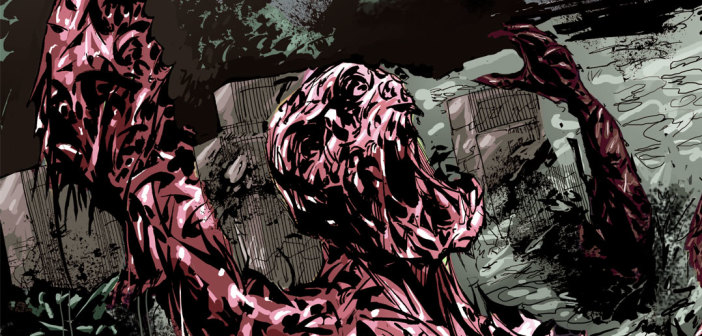Here’s how I would sum up Jamie Gambell and J.C. Grande’s four-part comic book miniseries, Omnitarium, but in order to do so, I will have to borrow the famous phrase of Victorian novelist Edward Bulwer-Lytton: “It was a dark and stormy night…” This book presents us with a classic tale of haunted prison cells, lurking monsters, pulp-like plots, and foppish characters that probably deserve what is coming to them.
The problem with Omnitarium is the curse of the comic book miniseries as a finished product: I’m not so sure that Gambell has given himself enough space to fully realize his narrative. Here we have the second issue, which means that the series is already half-way finished, and I’m completely lost. I hope that Gambell will be able to pull me back from the brink of confusion before he reaches his conclusion, but I have my doubts.
Issue two picks up right where the first one left off. The setting is Victorian London in 1869 and Pentansly Gaol is the forbidding fortress where the warden, Mr. Miller, and his guests are holed up. Don’t ask me to explain the presence of Miller’s three guests: Mr. Jameson, Mr. White, and Ms. St. Clair—I wouldn’t be able to provide any kind of worthwhile answer. I’m not really certain of their roles in the story other than to act as plot devices when the book needs to move along.
To refresh the memory of anyone who’s forgotten, the first issue introduced an evil sorcerer and his stalwart captor at a witch trial in 1772 before jumping to the Victorian era of London. I’m not sure of the importance or purpose of that initial flashback, as it’s a distant memory here in issue two. The narrative is primarily exposition, but of what exactly, I don’t know. More of the prison is revealed, which isn’t all that it seems to be. On top of that, monstrous happenings begin to plague the prison’s inner gaol, where all of society’s worst are housed.
The confusion of Omnitarium stems from the different directions the book is heading in. Part of it is somewhat sci-fi, while another is gothic horror, and it’s all topped off with some melodrama. But there’s no clear focus. I’m unable to interpret which way to look and exactly how to feel about everything that’s going on. This is all agitated by the fact that there are only two issues to go, when it’s clear Gambell probably needs about eight more if this is going to fully work.
Because I am not a mind reader, I don’t know how this comic book will ultimately finish. Yes, I’m confused now, but that’s the problem with issues, now isn’t it? The entire story isn’t revealed in one complete telling, but over the course of several installments. Perhaps all of this will wrap up with an intriguing twist. It’s not uncommon for some middle issues to hit a bump, while the overall product turns out fairly well. For anyone who read the first issue, keep up with it. I know I’m willing to, despite the problems here.
This comic book review originally appeared on Broken Frontier.




